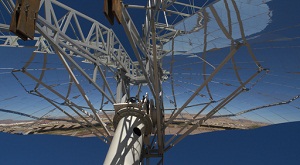Southwest Solar demonstrates proof-of-concept of solar dish CPV
 Phoenix, Ariz.-based Southwest Solar Technologies has completed proof of concept testing of a repurposing of its dish-based concentrating solar power (CSP) thermal turbine generator with a concentrating photovoltaic (CPV) application. The application puts the company on the path to delivering multiple technologies on a similar platform.
Phoenix, Ariz.-based Southwest Solar Technologies has completed proof of concept testing of a repurposing of its dish-based concentrating solar power (CSP) thermal turbine generator with a concentrating photovoltaic (CPV) application. The application puts the company on the path to delivering multiple technologies on a similar platform.
The company’s dish-based system is a modular approach to concentrated solar, whether it’s PV-based or turbine-based, said Southwest Solar Chief Technical Officer Herb Hayden.
“We think they offer more value,” he said.
The design is for a dish 75 feet in diameter with 300 square meters of mirrors to reflect and concentrate sunlight 1,200 times onto the collector. The technology should be able to produce about 250 kilowatts per acre.
“CPV tech has a lot of the similar attributes [as CSP],” Hayden said. “The design approach allows us to leverage the dish technology we’ve already worked on. It kind of diversifies and allows us to use a different technology with the same system.”
It also gives potential customers more opportunities to meet their needs.
“It’s a challenging market; we need to do things to try to minimize risk to people interested in new technologies,” he said. “We feel that the CPV system is another potential near-term [solution].”
The CPV system also uses a liquid-to-air cooling system, which offers the potential for other uses, domestic heating or water desalinization processing, according to Hayden. As currently configured, such a system wouldn’t be able to deliver enough heat to run an engine, however.
Both technologies are now in the proof of concept stage of development, according to Hayden.
“We’ve got additional work to do to bring them to the product level,” he said.
Whether or not the company could develop a combined CPV/CSP system remains to be seen.
“We are looking at whether there are ways to combine it,” Hayden said. There’s also no telling as whether or not such a system would be economically viable.
The company plans to build a 50-kilowatt system with the CPV technology next year, according to Hayden. After that it will move forward with the technology.



